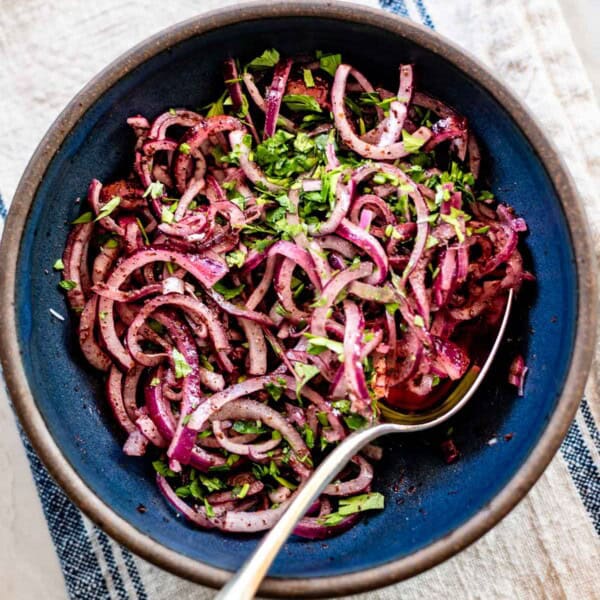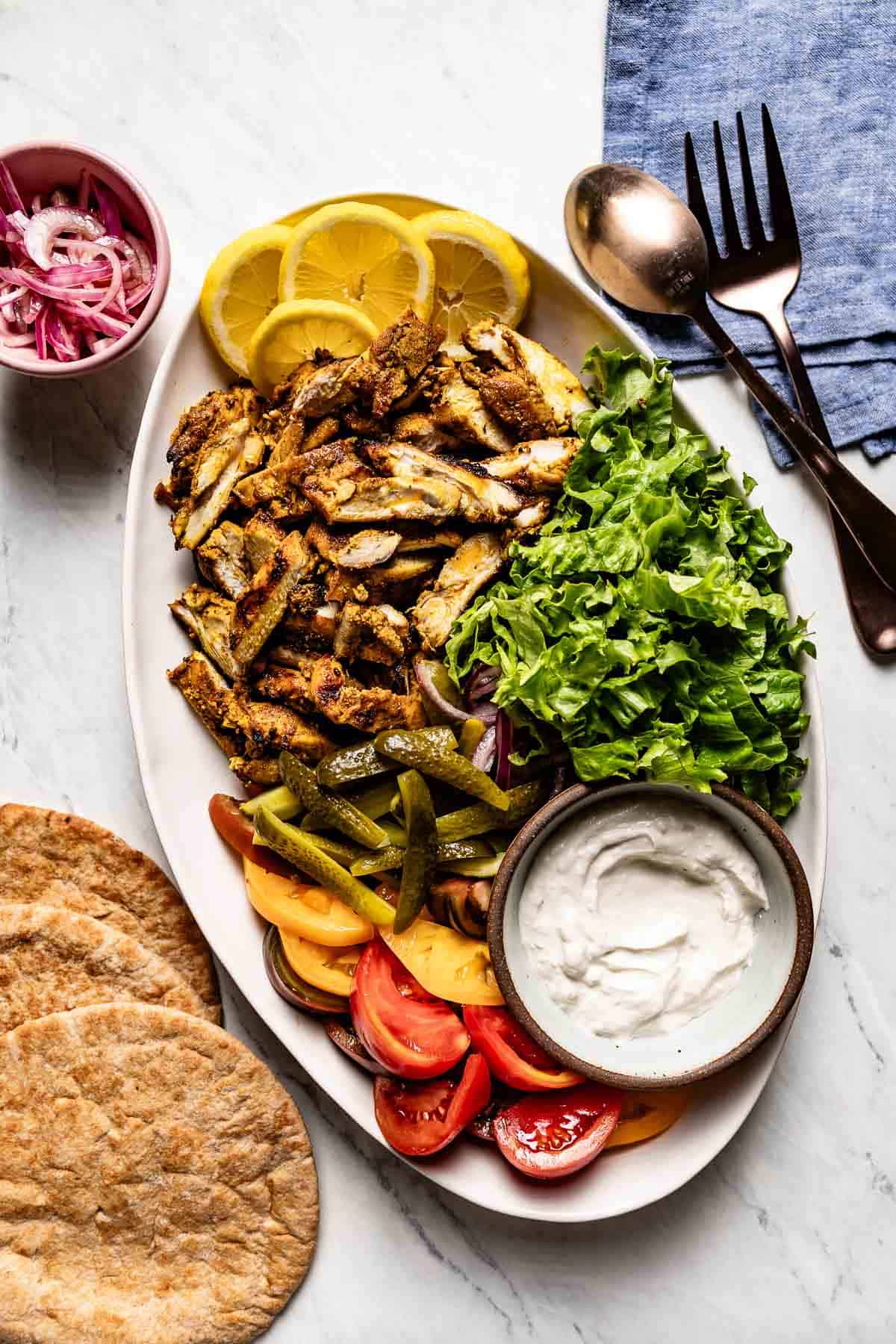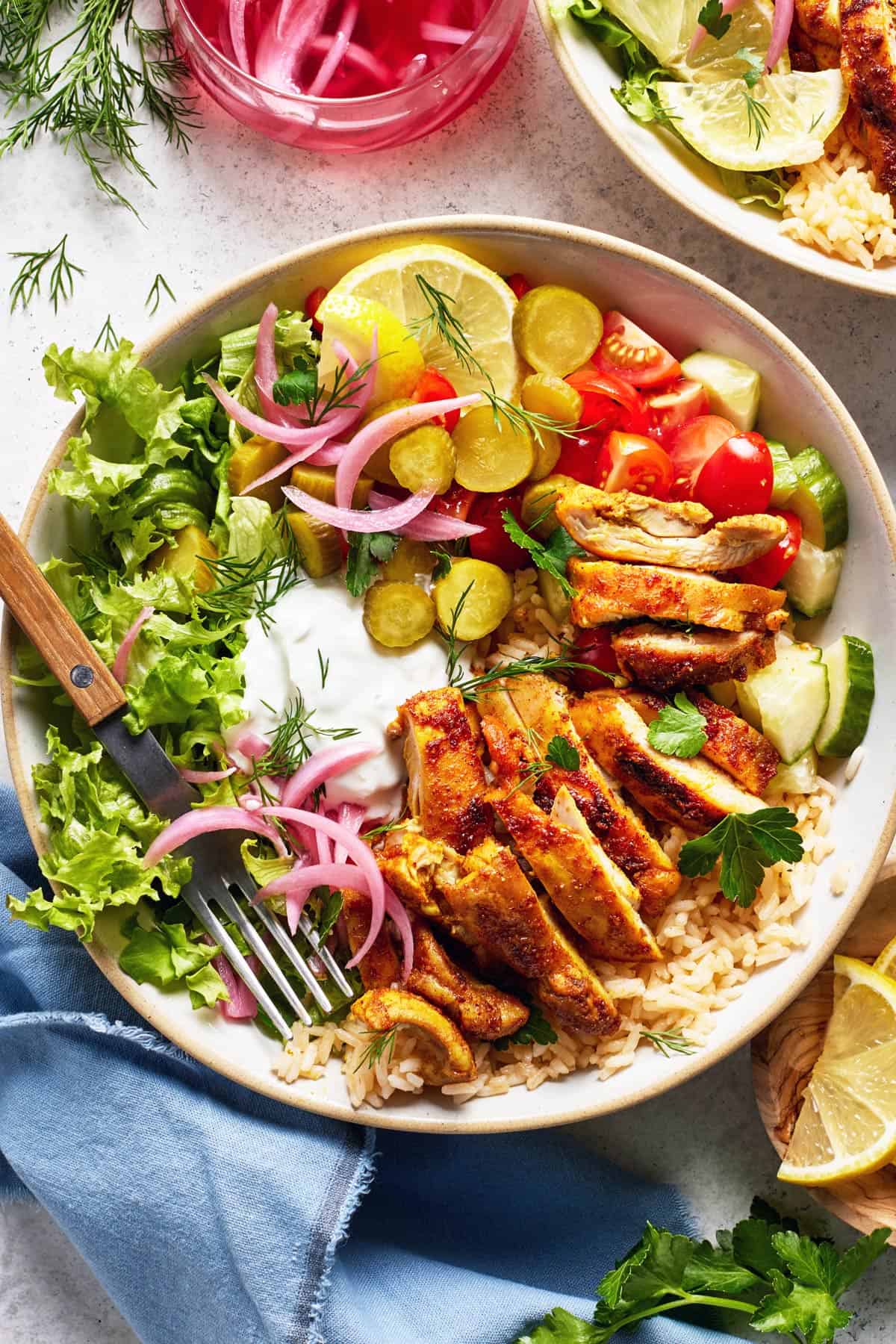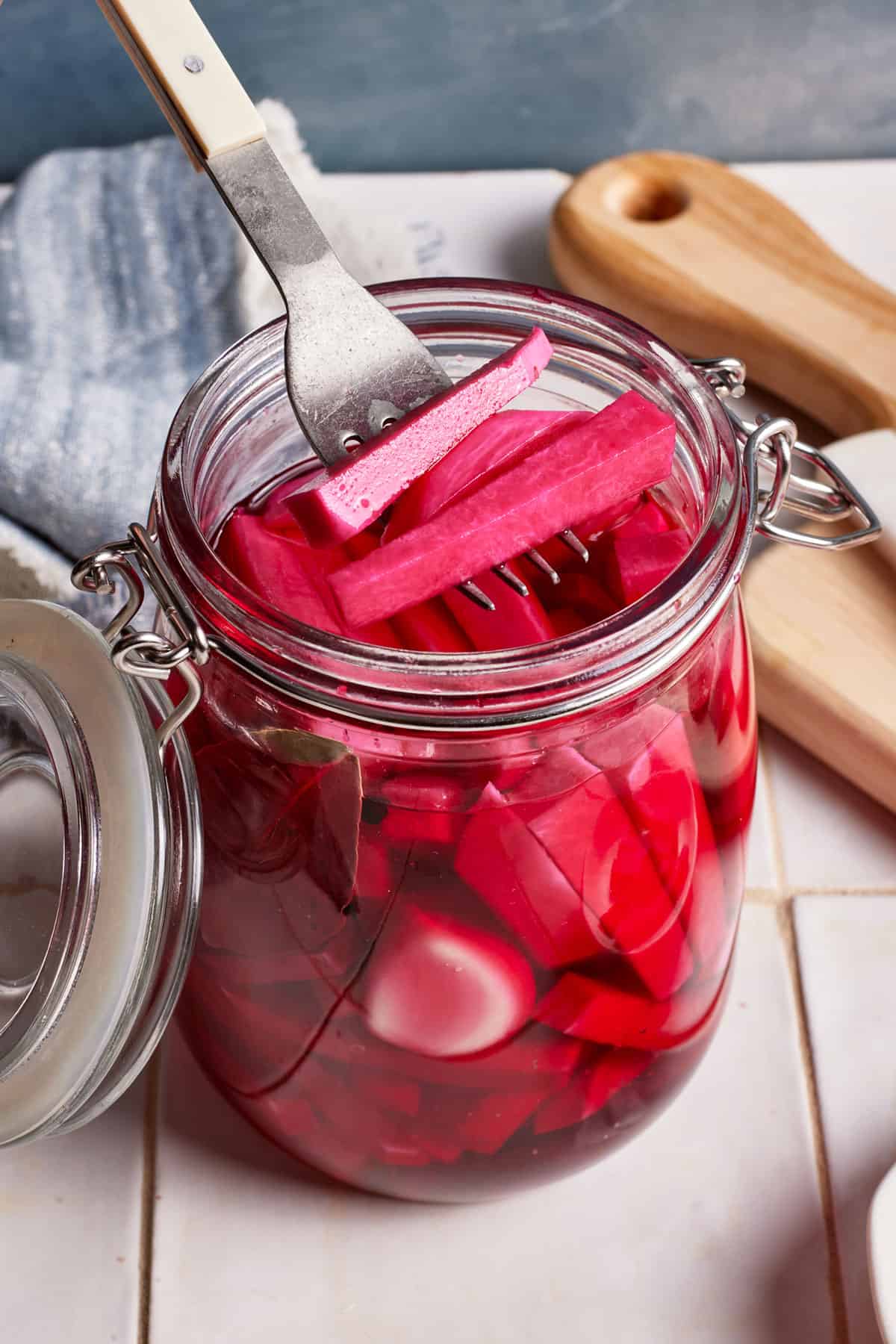What Are Sumac Onions?
Growing up in Turkey, sumac onions were always on the table. For us, they were what pickled onions are for many American homes: a simple, tangy side that brightens up almost any meal.
While we called it “sumac onions” and served it more like a condiment, some people also refer to it as a “red onion salad” and serve it as a side dish. Both are perfectly acceptable.
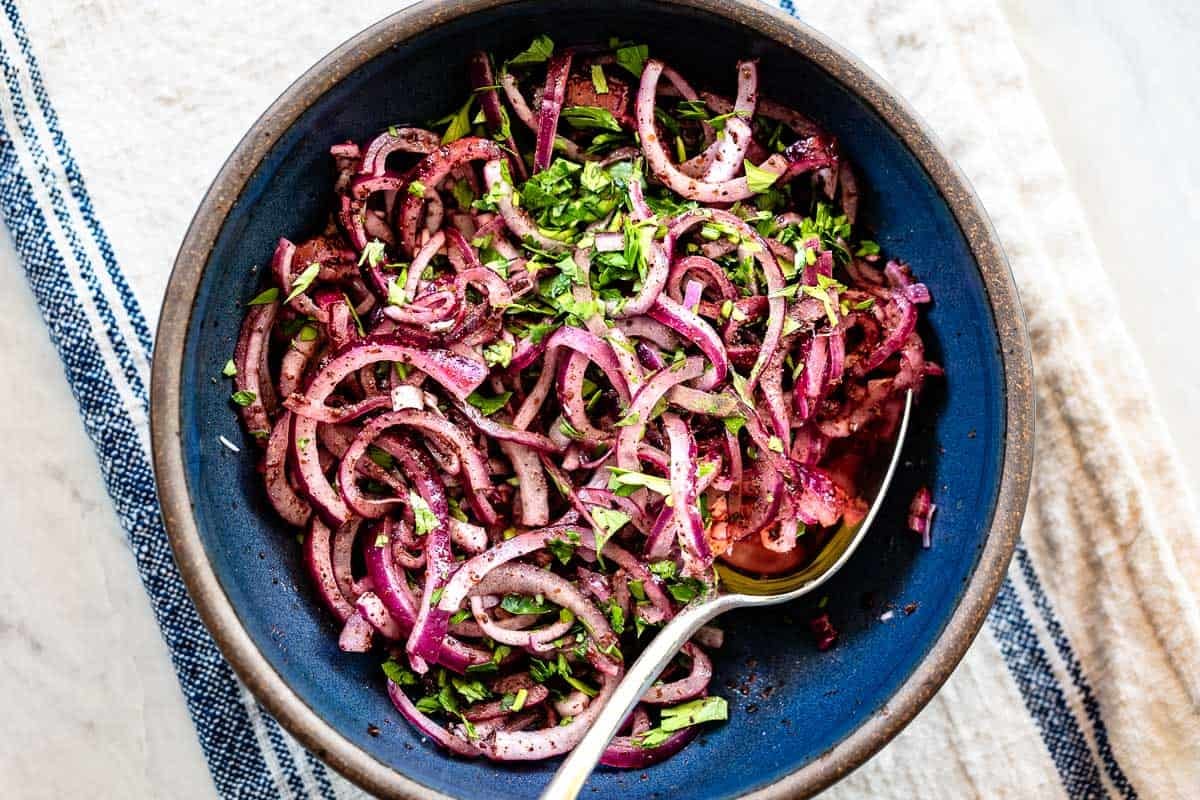
Now, in case you are not familiar, the key ingredient is sumac. It is a deep red spice made from dried berries (not peppers, though many people think so) with a tangy lemony flavor and slightly earthy taste. Unlike chili powders, it isn’t spicy hot.
When mixed with thinly sliced red onions, sumac helps tame their sharpness, turning them into a slightly sweet and refreshing bite. That’s why you’ll often see sumac onions served alongside meat-centric dishes like lamb, beef, or chicken kebabs. They cut through the richness and spice, bringing a welcome crunch and a pop of brightness to every bite.
Simple Ingredients You’ll Need
You’ll need only a few basic pantry staples to make this sumac onions recipe. You can find the complete list of ingredients in the recipe card below, but here are a few helpful notes from my recipe testing:
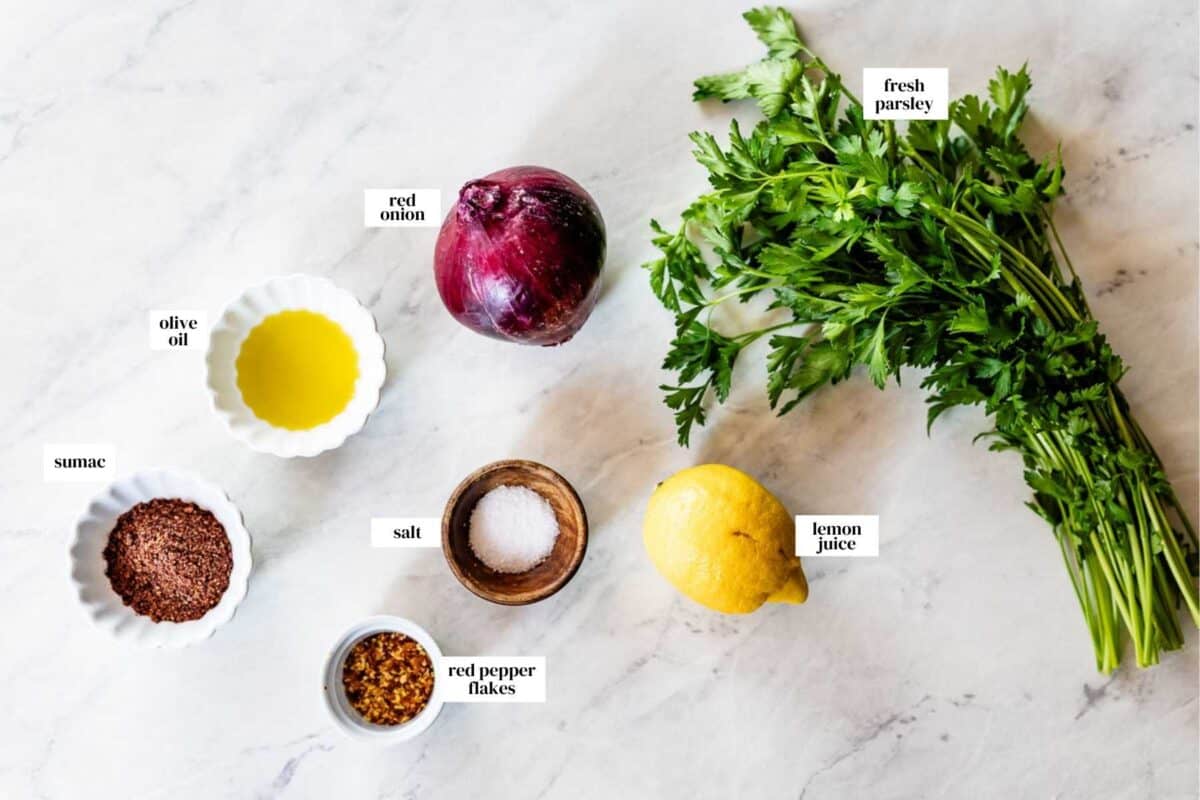
Red Onion: Since this is the main ingredient, use a fresh red onion and slice it as thinly as possible. A sharp knife works well, but a mandolin ensures even slices. In a pinch, you can substitute white or yellow onions, though the flavor will be slightly different.
Extra Virgin Olive Oil: A mild-flavored olive oil works best.
Lemon Juice: My mom always used lemon juice, as most Turkish families do, but other acidic ingredients like apple cider vinegar, red wine vinegar, or lime juice also work. Keep in mind, though, that the flavor profile will vary depending on the acid you use.
Kosher Salt: I used Diamond kosher salt, but if you are using other brands like Morton’s or sea salt, I would use half the amount and adjust it as necessary.
Sumac: Usually available in the Middle Eastern section of most supermarkets, sold as sumac spice or sumac powder. If you’re new to sumac, I really like Eastanbul sumac spice (affiliate link). Keep an eye on the best-by date, since sumac typically has a shorter shelf life than many other spices, about 6 months.
Red Pepper Flakes (Urfa Chili or Aleppo Pepper): Optional, but the authentic version often uses a pinch of Urfa chili or Aleppo pepper. If you can’t get your hands on either one of those, any other red pepper flakes you have on hand would also work.
Fresh Chopped Parsley: Finely chopped parsley is traditional, but you can switch it up depending on the dish you are serving it with. For example, fresh mint pairs beautifully when serving with lamb.
Pomegranate molasses (optional): A drizzle of pomegranate molasses is optional, but it would add a nice sweetness, especially if you are serving this with kebabs.
Tomatoes (optional): If I am serving this sumac onion salad with lamb kabobs like the traditional Adana Kebab, I add a handful of halved cherry tomatoes. They bring a pop of color and an extra touch of freshness.
How to Make Sumac Onions (Step-by-Step Guide)
Making Turkish sumac onions is as straightforward as it gets. You don’t need any special equipment, just a sharp knife and a bowl. Follow these simple steps, and you’ll have a tangy, refreshing side ready to serve with your favorite dishes.

Step 1 – Slice the onions: On a sturdy cutting board, cut the red onion in half lengthwise. Remove the skins and slice thinly into half-moon shapes. A sharp knife works best, but always keep the flat side of the onion against the board for safety.
Step 2 – Mix the ingredients: Place the sliced onion in a medium bowl. Add the olive oil, lemon juice, kosher salt, sumac, and Aleppo pepper (if using).

Step 3 – Massage: Using clean hands, gently massage the onions for 1-2 minutes, until they have softened slightly and absorbed the seasonings.
Step 4 – Garnish and rest: Sprinkle with chopped parsley and toss to combine. If you have the time, cover and refrigerate for 10-15 minutes before serving to let the flavors meld.
Helpful Expert Tips
Whether you’re serving sumac pickled onions as a condiment for kebabs or tucking them into sandwiches, this recipe is simple enough for anyone to make. Still, a few tips can help you get the best results on your first try:
- Soak the onions if needed: If you’re sensitive to the strong, pungent taste of red onions, soak the slices in cold tap water with a pinch of salt for about 10 minutes, then drain before mixing. This works especially well if you plan to serve them right away. However, keep in mind that if you are making them ahead, this step is unnecessary, as their sharpness naturally mellows as they sit in the fridge.
- Use fresh sumac: Unlike many other spices, sumac has a relatively short shelf life. Check the freshness before using it. I list one tablespoon in the recipe, but I often add closer to 2 tablespoons at home because I love the flavor. Taste and adjust to your preference.
- Slice evenly: Try to cut the onions into even slices so each bite has the same texture and balance of seasoning. A mandolin can be helpful, but a sharp chef’s knife works just fine.
- Don’t skip the massage: Gently massaging for a minute not only softens the onions but also helps them absorb the sumac and other seasonings more fully.
- Serve slightly chilled: While you can enjoy them right away, serving them chilled adds a refreshing crunch that pairs especially well with rich meat dishes.
- Watch out for stains: Sumac has a deep red color, and when mixed with red onions, it can easily stain.. Avoid wearing your favorite white shirt while preparing it, and consider using gloves if you prefer.
Delicious Ways to Serve Sumac Onions
The pairing options are endless for this Turkish onion salad. While you can serve it with nearly any savory dish, here are some of my favorite ways to enjoy it:
- With Kebabs & Grilled Meats: Sumac onions are the classic pairing with the rich, smoky kebabs that Turkish, Lebanese, and other Middle Eastern cuisines are known for. I especially love to serve on top of my Adana Kebab, Chicken Shish Tawook, Doner Kebab, and Oven Chicken Kebabs.
- With Shawarma: Their tangy bite balances the spices in shawarma beautifully. Try them with my Easy Chicken Shawarma or Beef Shawarma.
- In Bowls: Add freshness and brightness to grain or salad bowls. They’re perfect on top of a Chicken Shawarma Bowl or a Homemade CAVA Bowl.
- With Seafood Dishes: They pair wonderfully with Grilled or Baked salmon, adding contrast to the richness of the fish.
- Make it a part of your mezze platter: Serve it along with other mezze platter staples like Hummus, Muhammara, and Baba Ganoush.
- Vegetarian & Vegan Favorites: Sumac onions bring life to plant-based meals, adding a burst of freshness that makes every bite more satisfying. I love serving them alongside Rice with Vermicelli or crispy Falafel.
Storing Leftovers & Making Ahead
Making Ahead: This recipe is perfect for meal prep since the onions continue to mellow and develop flavor as they sit. You can make them 2–3 days in advance and store them in an airtight container or mason jar in the fridge.
Storing Leftovers: Keep leftovers refrigerated for 3 to 4 days. Just give them a quick stir before serving to mix the seasonings back in.
Freezing: Freezing isn’t recommended, as the onions lose their crisp texture once thawed. For the best taste and crunch, enjoy them fresh.
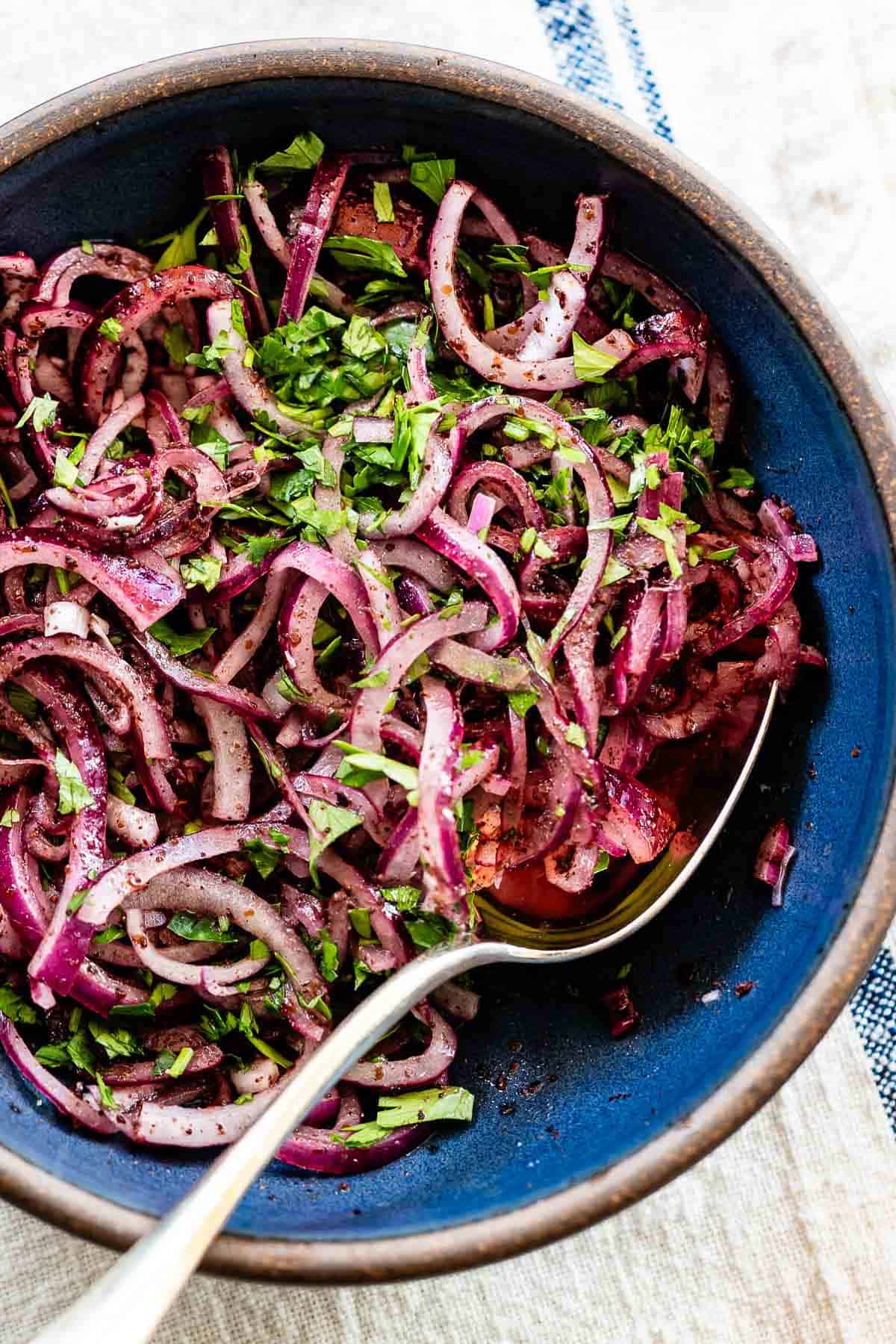
FAQs
Sumac onions have a bright, tangy taste with a hint of sweetness. The sumac adds an earthy, citrus-like note that softens the sharpness of raw red onions.
If you find raw onions too sharp, soak the slices in a bowl of cold water with a pinch of salt for about 10 minutes, then drain well before using.
They should last for 3-4 days as long as they are stored in an airtight container or a jar with a tight-fitting lid.
Yes, absolutely. Sumac onions are very versatile. You can drizzle in a little pomegranate molasses for extra sweetness, swap in fresh mint instead of parsley, or add spices like ground cumin for a different twist.
Other Middle Eastern/Mediterranean Condiments You Might Like
If you enjoy this onion sumac salad, chances are you’ll love other Middle Eastern and Mediterranean condiments too. Here are a few to try next:
- If you’re a fan of the bold, spicy flavors of the region, my homemade harissa recipe is a must-try.
- Bright and earthy with lemon and garlic, tahini sauce is one of the easiest ways to add depth to grilled meats or roasted vegetables.
- When you want to mellow out the richness of kebabs or grilled meats, everyone’s favorite creamy Greek white sauce (known as tzatziki) made with cucumber, garlic, and dill is hard to beat.

Sumac Onions Recipe
Ingredients
- 1 red onion, medium sized
- 1 tablespoon olive oil
- 2 tablespoons lemon juice
- ½ teaspoon Kosher salt
- 1 tablespoon sumac
- ¼ teaspoon Urfa or Aleppo pepper , or red pepper flakes
- 2 tablespoons fresh parsley, chopped
Instructions
- Cut onions in half lengthwise, remove the skins, and slice thinly into half-moon shapes. Transfer to a medium bowl.
- Add the olive oil, lemon juice, Kosher salt, sumac, and Aleppo pepper.
- Using your hands, gently massage the onions for 1–2 minutes until they soften slightly and absorb the seasonings.
- Add the parsley and toss to combine.
Notes
- Yields: This recipe makes ½ to ¾ of sumac onions, which would be ideal for serving 4 adults. The nutritional values below are per serving.
- Onions: While the traditional recipe is made with red onions, in a pinch, you can use white onions, but keep in mind that the flavor profile will be slightly different.
- Make Ahead: These onions get even better as they sit. You can prepare them 2-3 days in advance and store them in an airtight container or jar in the fridge.
- Storage: Store leftovers in the fridge for up to 4 days. Just give them a quick stir before serving to mix the seasonings back in.
- Freezing: Not recommended, as the onions lose their crisp texture once thawed. For the best flavor and crunch, enjoy them fresh.
Nutrition
Nutrition information is automatically calculated, so should only be used as an approximation.
